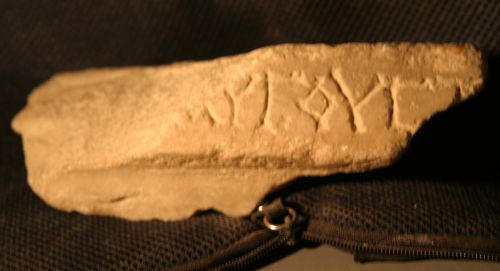Byzantine 28: Dedication of an emperor (ed. A. Vinogradov)
Stone.
Type of monument: Cornice. Material: White small-grained marble. Description and condition: A cornice embellished with a ledge and two concentric mouldings. On the back side – 2 dowel holes. Obverse side polished. Broken, 2 fragments survive. Frag. 1 is damaged on the top and right side, and the bottom left corner is chipped off.; Frag. 2 is damaged on all sides apart from the top.
Fragment 1. Dimensions: H. 0.095, W. 0.31, Th. 0.135. Autopsy: May 1999, August 2001, September 2002, September 2003, September 2004, September 2005, September 2006, September 2007.
— Find place: Chersonesos. Find circumstances: 1893, excavations of K.K. Kostsyushko-Valyuzhinich. Find context: Temple 22 ("Northern basilica").
Modern location: Sebastopol, Ukraine. Institution and inventory: National Preserve of Tauric Chersonesos 35117.
Fragment 2. Dimensions: H. 0.06, W. 0.18, Th. 0.135. Autopsy: May 1999, August 2001, September 2002, September 2003, September 2004, September 2005, September 2006, September 2007.
— Find place: Chersonesos. Find circumstances: unknown. Find context: unknown.
Modern location: Sebastopol, Ukraine. Institution and inventory: National Preserve of Tauric Chersonesos 3345.
Text field:
Faces code: f1. Style of lettering: Lapidary. Letters embellished with serifs. Alpha with a broken crossbar, rectangular epsilon and sigma, omega in the shape of an upside down mu. Letterheights: 0.023.
Text:
Origin of text: Chersonesos. Document type: Dedication. Date: 6th century CE. Dating criteria: Archaeological context and letterforms.
Editions: Fragment 1. L1. Latyshev 1895a, 24, no. 30; 1.1 Collection 17. Fragment 2: unedited.
+ Ὑπὲρ σωτηρίας κ[αὶ ... Ἰουστινιανοῦ e.g.] αὐγούστ[ου


Translation:
For the salvation and [… of Justinian (?)] emperor.
Commentary:
The origin of Frag. 2 is unknown, but the cornice’s profile and the letterforms leave no doubt that it belongs to the same inscription as Frag. 1.
On the dedicatory formula and its possible reconstruction, see IV.3.B.c.
A kappa that follows σωτηρίας must be the beginning of a conjunction κ[αὶ "and", rather than the first letter of a name. The letters ΑΥΓΟΥΣΤ on Frag. 2 further complicate matters. Because in dedications where such formulae are used, a date is never given by month, these letters must indicate either an emperor’s title or his personal name. Personal names Augustus or Augusta are not attested in Byzantium, and the name Augustine does not occur in inscriptions. Therefore, the most likely scenario is that the letters indicate an imperial title. It is quite possible that an emperor could have provided money for the construction or renovation of a temple: compare a similar votive formula in Mango 1951, 66, no. H2 B (Constantinopole, 457-474 CE): [Ὑπἐρ εὐχῆς τ]οῦ βασιλέως [Λέοντο]ς α<ὐ>γούστου.
Regarding the archaeological dating of the Temple 22, see my commentary to Byz. 19. Rectangular epsilon and sigma are similar to those on Byz. 6, but ypsilon-shapen epsilon finds an even closer parallel in Byz. 22.
The cornice was found in the same Temple 22 as Byz. 19 – a dedication of Theodore on a panel of altar partition - but the script is very different there: rectangular letters with serifs, with vertical ypsilon. The letterforms and the difference in votive formulae virtually exclude the possibility of our inscription belonging to the same templon as Byz. 19. Instead we have to conclude that two types of script were used in the same temple structure: a more archaic, rounded (Byz. 19) and a newer, angular type that appears some time in the 6th century CE (cf. Byz. 29). The two scripts could co-exist only within one century, and most likely in the middle of that century. If, however, the two scripts were not contemporary, it would be very unlikely for a templon panel with the archaic script to be later than the construction of the temple with a cornice inscribed in a newer script. Conversely, it would be unlikely for that panel to survive the temple’s reconstruction when the cornice in question would have been installed in it. The only remaining possibility that could fit a scenario of non-contemporaneous use of the two scripts is where the cornice belongs to some auxiliary structure adjunct to Temple 22, but no architectural additions or reconstructions are attested for the “Northern basilica” in the Early Byzantine period (see Bernatzki, Klenina, Rhyzhov 2004, 67). Thus, Byz. 19 and 29 must be contemporary and date to the 6th century CE (see above). In this century, however, no emperors’ names start with kappa, excluding that possibility of reconstructing Byz. 28. With some caution, therefore, we may suggest that the construction of Temple 22 is to be connected with building activities of emperor Justinian I.